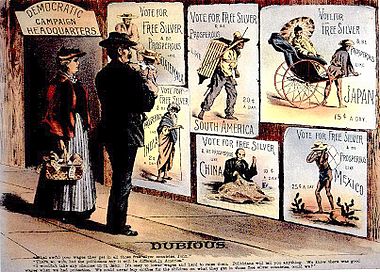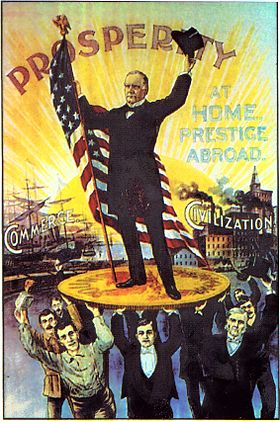Bimetallism
In economics, bimetallism is a monetary standard in which the value of the monetary unit can be expressed either with a certain amount of gold or with a certain amount of silver. The ratio between the two metals is fixed by law. In economic history the debate took place primarily inside the United States in the late 19th century, as the U.S. was the only major country that was a large producer of both gold and silver.
This monetary system is very unstable. Due to the fluctuation of the commercial value of the metals, the metal with a commercial value higher than the currency value tends to be used as metal and is withdrawn from circulation as money (Gresham's Law). This occurred in the United States throughout the 19th century as the official bimetallic standard became in effect a silver standard.
Political debate — 1890s U.S.
In the United States, toward the end of the nineteenth century, bimetallism became a center of political conflict. Newly discovered silver mines in the American West caused an effective decrease in the value of money. In 1873 the government passed the Fourth Coinage Act, at the same time as these resources were beginning to be exploited. This was later referred to by Silverites as “The Crime of ’73,” as it was judged to have inhibited inflation. Instead deflation resulted, causing problems for farmers with large mortgages but who could sell their goods for only a fraction of their post-Civil War price. In addition, improvements in transport meant it was cheaper for farmers to ship their grain to Europe, and they over-expanded production until there was a glut on the market. The Panic of 1893 was a severe nationwide depression that brought the money issue to the fore. The "silverites" argued that using silver would inflate the money supply and mean more cash for everyone, which they equated with prosperity. The gold advocates said silver would permanently depress the economy, but that sound money produced by a gold standard would restore prosperity. The gold advocates won decisively in 1896 and 1900.
Bimetallism and "Free Silver" were demanded by William Jennings Bryan who took over leadership of the Democratic Party in 1896, as well as the Populist and Silver Republican Parties. The Republican Party nominated William McKinley on a platform supporting the gold standard which was favored by financial interests in the East Coast. A faction of Republicans from silver mining regions in the West known as the Silver Republicans endorsed Bryan.
Bryan, the eloquent champion of the cause, gave the famous “Cross of Gold” speech at the National Democratic Convention on July 9, 1896 asserting that “The gold standard has slain tens of thousands.” He referred to “a struggle between ‘the idle holders of idle capital’ and ‘the struggling masses, who produce the wealth and pay the taxes of the country;’ and, my friends, the question we are to decide is: Upon which side will the Democratic party fight?” At the peroration, he said “You shall not press down upon the brow of labor this crown of thorns, you shall not crucify mankind upon a cross of gold.” However, his presidential campaign was ultimately unsuccessful due to economic upturn caused in part by the failure of Russian harvests and the resultant increase in commodity prices. The 1896 election saw the election of William McKinley who implemented the gold standard and ran on it in his 1900 reelection. The standard lasted until the Great Depression. It was abandoned in 1934 in FDR’s New Deal economic recovery program.
As Friedman and Schwarz (1963) have shown, the money supply was steadily expanding in the 1890s because bank checks were becoming common.
Wizard of Oz
Since the 1960s historians and economists have explored the bimetallism symbolism in The Wizard of Oz. The original 1900 book centers on a yellow brick road (gold), traversed by magical silver slippers (the 1939 movie changed them to ruby slippers), as Dorothy leads a political coalition of farmers (Scarecrow), workers (Tin Woodman) and politicians (Cowardly Lion) to petition the President (Wizard) in the capital city of Oz (the abbreviation for ounce, a common unit of measure for precious metal). The real enemy of the little people (Munchkins) is the giant corporation or Trust (Wicked Witch of the West), whom Dorothy dissolves, just as the progressives of the era tried to dissolve the corporate trusts.
Monometallism
The practical difficulties which in times past had confronted the maintenance of a joint standard, a concurrent circulation of the two metals, led one nation after another to abandon the effort, and to adopt a system of monometallism, with gold as its basic unit of trade.
The historical development of coinage in modern nations has been from silver monometallism through a more or less unsatisfactory experience with bimetallism, to the single gold standard. Still, in the twentieth century, both metals lost their former importance within monetary systems. Now, monometallism in the form of the gold standard has been abandoned by all nations.
Primary sources
- Campaign Text-book of the National Democratic Party (1896) by Democratic Party (U.S.) National Committee: this is the Gold Democrats handbook; it strongly opposed Bryan.
- Walker, International Bimetallism (New York, 1896)
- Robert Giffen, Case against Bimetallism (London, 1896)
- Joseph Shield Nicholson, Money and Monetary Problems (London, 1897)
- Samuel Dana Horton, The Silver Pound (London, 1887)
- Walker, Money (New York, 1878)
- Francis Amasa Walker, Money, Trade and Industry (New York, 1879)
- Elisha Benjamin Andrews, An honest Dollar (Hartford, 1894)
- Helm, The Joint Standard (London, 1894)
- Frank William Taussig, The Silver Situation in the United States (New York, 1893)
- Horace White (writer), Money and Banking (Boston, 1896)
- James Laurence Laughlin, History of Bimetallism in the United States (New York, 1897)
- Langford Lovell Price, Money and its Relations to Prices (London and New york, 1896)
- Utley, Bimetallism (Los Angeles, 1899)
- Roger Q. Mills, What shall we do with silver? (The North American Review, Volume 150, Issue 402, May 1890.)
References
- James A. Barnes, "Myths of the Bryan Campaign," Mississippi Valley Historical Review, 34 (Dec. 1947) online in JSTOR
- David T. Beito and Linda Royster Beito, "Gold Democrats and the Decline of Classical Liberalism, 1896-1900,"Independent Review 4 (Spring 2000), 555-75.
- Bordo, Michael D. "Bimetallism." In The New Palgrave Encyclopedia of Money and Finance edited by Peter K. Newman, Murray Milgate and John Eatwell. 1992.
- Dighe, Ranjit S. ed. The Historian's Wizard of Oz: Reading L. Frank Baum's Classic as a Political and Monetary Allegory (2002)
- Friedman, Milton, 1990a, "The crime of 1873," Journal of Political Economy, Vol. 98, No. 6, December, pp. 1159-1194
- Friedman, Milton, 1990b, "Bimetallism revisited," Journal of Economic Perspectives, Vol. 4, No. 4, Fall, pp. 85-104.
- Friedman, Milton, and Anna J. Schwartz, 1963, A Monetary History of the United States, 1867-1960
- Jeansonne, Glen. "Goldbugs, Silverites, and Satirists: Caricature and Humor in the Presidential Election of 1896." Journal of American Culture 1988 11(2): 1-8. Issn: 0191-1813
- Jensen, Richard J. (1971). The Winning of the Midwest: Social and Political Conflict 1888–1896.
- Jones, Stanley L. (1964). The Presidential Election of 1896.
- Littlefield, Henry M., 1964, "The Wizard of Oz: Parable on Populism," American quarterly, Vol. 16, No. 1, Spring, pp. 47-58.
- Angela Redish, "Bimetallism"
- Rockoff, Hugh, 1990, "The Wizard of Oz as a monetary allegory," Journal of Political Economy, Vol. 98, No. 4, August, pp. 739-760.
- Velde, Francois R. "Following the Yellow Brick Road: How the United States Adopted the Gold Standard" Economic Perspectives. Volume: 26. Issue: 2. 2002.
- Richard Hofstadter (1996). “Free Silver and the Mind of "Coin" Harvey”, The Paranoid Style in American Politics and Other Essays. Harvard University Press. Harvard.. ISBN 0-674-65461-7.
See also
External link
- The Bimetallic Standard, a series of pages on bimetalism from Micheloud & cie.
cs:Bimetalismus de:Bimetallismus it:Bimetallismo hu:Bimetallizmus ru:Биметаллизм sk:Bimetalizmus fi:Bimetallijärjestelmä uk:Біметалізм

